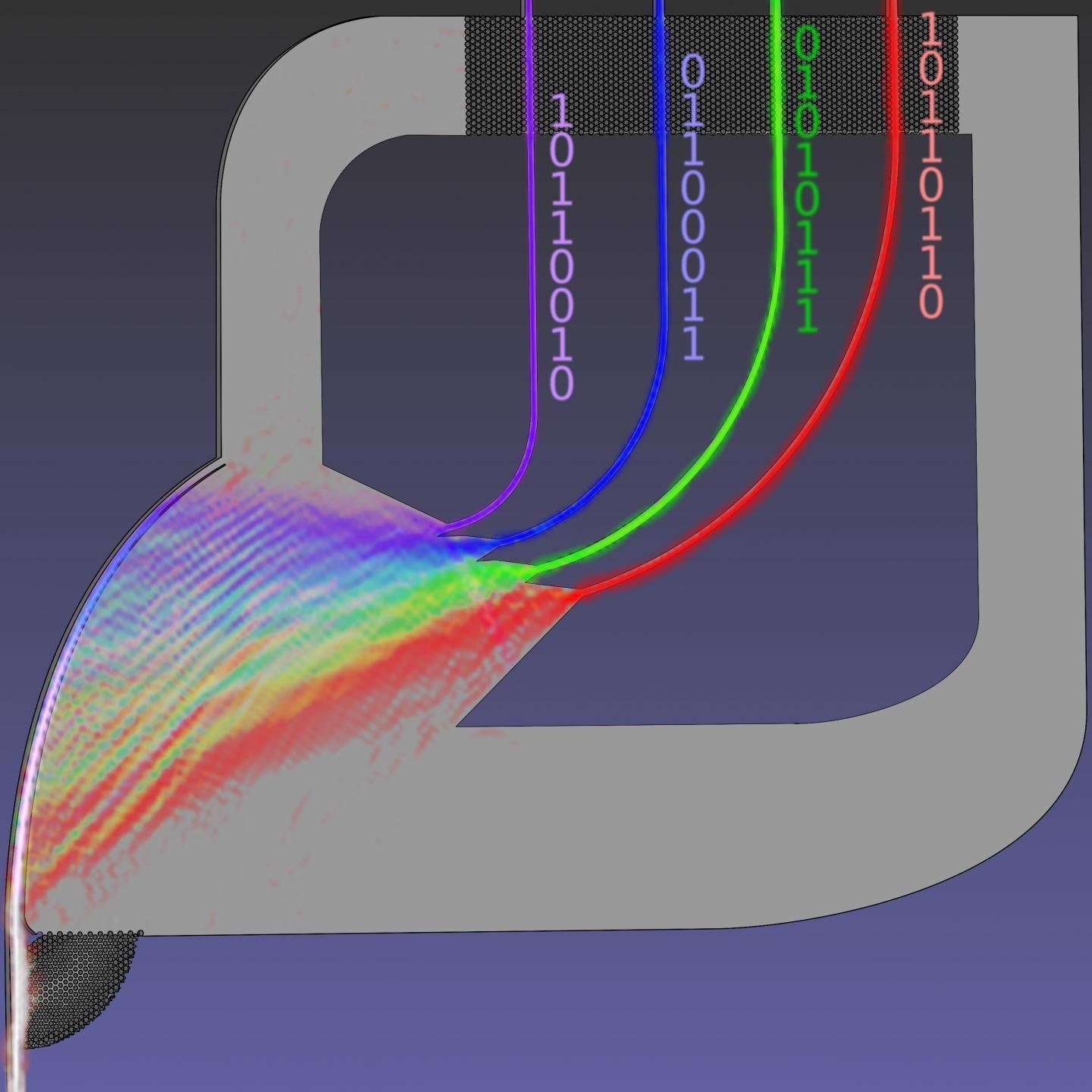Apr 30 2021
A new multiplexer has now been created from pure silicon for terahertz-range communications in the 300-GHz band. The feat was achieved by a collaboration of scientists from Osaka University, Japan, and the University of Adelaide, Australia.
 Schematic of the integrated multiplexer, showing broadband terahertz wave being split into four different frequencies, where each is capable of carrying digital information. Image Credit: Osaka University.
Schematic of the integrated multiplexer, showing broadband terahertz wave being split into four different frequencies, where each is capable of carrying digital information. Image Credit: Osaka University.
In order to control the great spectral bandwidth of terahertz waves, a multiplexer, which is used to split and join signals, is critical for dividing the information into manageable chunks that can be more easily processed and so can be transmitted faster from one device to another. Up until now compact and practical multiplexers have not been developed for the terahertz range.
Withawat Withayachumnankul, Associate Professor, School of Electrical and Electronic Engineering, University of Adelaide
“The new terahertz multiplexers, which are economical to manufacture, will be extremely useful for ultra-broadband wireless communications. The shape of the chips we have developed is the key to combining and splitting channels so that more data can be processed more rapidly. Simplicity is its beauty,” added Withayachumnankul.
Throughout the world, people are highly making use of mobile devices to access the internet and the various connected devices are rapidly increasing. Very soon, machines will be interacting with each other in the Internet of Things, which will need highly powerful wireless networks that are capable of moving huge volumes of data rapidly.
Terahertz waves are considered to be a part of the electromagnetic spectrum that possesses a raw spectral bandwidth that is much wider compared to that of traditional wireless communications, which depend on microwaves. The researchers have designed ultra-compact and efficient terahertz multiplexers, with the help of an innovative optical tunneling process.
A typical four-channel optical multiplexer might span more than 2000 wavelengths. This would be about two meters in length in the 300-GHz band. Our device is merely 25 wavelengths across, which offers dramatic size reduction by a factor of 6000.
Dr Daniel Headland, Study Lead Author, Osaka University
The latest multiplexer has the ability to cover a spectral bandwidth of more than 30 times the total spectrum allocated in Japan for 4G/LTE, the fastest mobile technology available now, and 5G, which is the next generation, integrated. Bandwidth is associated with data rate, and thus, ultra-high-speed digital transmission can be performed with the new multiplexer.
Our four-channel multiplexer can potentially support aggregate data rate of 48 gigabits per second (Gbit/s), equivalent to that of uncompressed 8K ultrahigh definition video being streamed in real time. To make the entire system portable, we plan to integrate this multiplexer with resonant tunnelling diodes to provide compact, multi-channel terahertz transceivers.
Masayuki Fujita, Associate Professor and Team Leader, Osaka University
The modulation scheme utilized in the study was more fundamental. Terahertz power was just switched on and off to send binary data. More modern methods are available to compress even higher data rates toward 1 Terabit/second into a specified bandwidth allocation.
“The new multiplexer can be mass-produced, just like computer chips, but much simpler. So large-scale market penetration is possible. This would enable applications in 6G and beyond, as well as the Internet of Things, and low-probability-of-intercept communications between compact aircraft such as autonomous drones,” stated Professor Tadao Nagatsuma from Osaka University.
This study was financially supported by the Japan Science and Technology Agency (JST) CREST funding program, KAKENHI grant, and an Australia Research Council (ARC) Discovery grant. The research builds on the team’s study in 2020 when they made substrate-free, metal-free, silicon micro-photonics for effective integrated terahertz devices. This innovation had set the stage to transform present nanophotonic multiplexers into the terahertz realm.
Journal Reference:
Headland, D., et al. (2021) Gratingless integrated tunneling multiplexer for terahertz waves. Optica. doi.org/10.1364/OPTICA.420715.